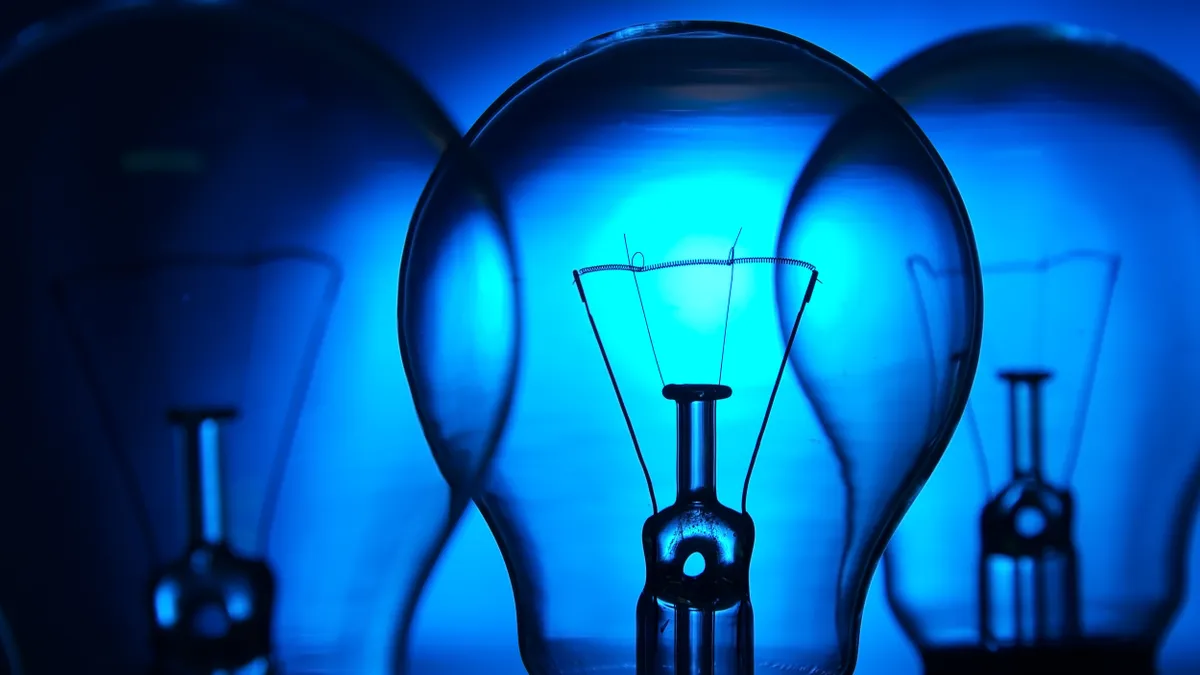Dive Brief:
- The California Energy Commission (CEC) on Nov. 13 approved new lightbulb efficiency standards that will effectively prevent incandescent and halogen bulbs from being sold in the state starting in 2020.
- As a result of this move, California also adopted a 2017 Obama administration decision to expand the amount of commonly-used bulbs that must meet requirements to be about 65% more efficient than incandescent bulbs, about a week after California and other states sued the U.S. Department of Energy (DOE) for reversing the Obama decision.
- California is engaged in a legal battle with the Trump administration over the state's pursuit of vehicle emissions standards that are more stringent than those supported by the White House. A 2007 federal law says California can implement lightbulb standards without federal preemption.
Dive Insight:
After the existing stock of lightbulbs in the state turns over to higher-efficiency bulbs like LEDs, the regulations will save California between $736 million and $2.4 billion annually from lower electricity costs, according to the proposed version of the regulations from CEC staff. They will also save between 2,290 and 4,600 GWh of electricity in the first year, the staff said.
The efficiency gains from the commission's decision will be "above and beyond" standards the state implemented in 2018 affecting some bulbs, Natural Resources Defense Council (NRDC) Center for Energy Efficiency Standards Director Noah Horowitz wrote in a blog post.
California’s existing lighting standards have had a noticeable effect on energy efficiency, as seen in the plans of one of the state’s largest utilities, Southern California Edison (SCE). Installing more efficient lighting is one of the cheapest and simplest types of efficiency upgrades. The existing standards have essentially picked the lowest-hanging fruit when it comes to energy savings, leading to relatively lower efficiency targets going forward because continued savings will be more difficult to achieve.
“SCE’s 2020 energy efficiency goals, established by the California Public Utilities Commission in August 2019, reflect a significant reduction in energy savings potential relative to the previous year,” according to a prepared statement sent to Utility Dive from SCE spokesman Ron Gales.
“This reduced potential and the resulting reduction in energy efficiency goals in California is due in large part to the increased lighting efficiency standards in both residential and non-residential sectors. While this decrease in potential reduced SCE and statewide utility energy efficiency goals, the remaining market potential for energy efficiency savings is expected to be more challenging to cost-effectively achieve relative to energy savings from previous measures such as energy efficient lighting,” the statement continued.
SCE’s proposed 2020 energy efficiency portfolio budget is $147.63 million, compared to a $230.17 million budget in 2019.
Under federal law, neither California nor Nevada are precluded from adopting their own rules requiring "general service lamps", a broad category of everyday light bulbs, to be more efficient if the federal government does not do so, as laid out in the 2007 Energy Independence and Security Act (EISA).
That 2007 law has a "backstop" requirement that, barring other federal actions to achieve equivalent lighting energy savings, by Jan. 1, 2020, the federal government must prohibit general service lamps that do not meet a standard of 45 lumens per watt.
"California exercised its rights and went forward with its adoption of DOE's updated definitions from 2017 and applied the EISA law backstop of 45 lumens per watt, which essentially means no more sales of incandescents and halogens in California as of January 1," NRDC spokesperson Pat Remick told Utility Dive in an email.
The Trump administration, however, has argued that it is not failing to implement the 45 lumen per watt standard, but rather that it believes that the Obama administration's expansion of the definition of general service lamps to include more types of bulbs was illegal.
These additional bulbs that California is regulating under the expanded definition include the three-way, flame- or candle-shaped and globe-shaped bulbs used in bathroom vanities. Not regulating these bulbs "cuts in half" the 2.7 billion sockets around the country that allow bulbs that fall under the California and Obama administration's approach, according to the NRDC.
California has already put in place lightbulb regulations that go beyond what the Trump administration wants to implement. Since 2018, the state has required the 45 lumen per watt standard for commonly-used pear-shaped incandescent bulbs.
"There are no incandescent or halogen bulbs on the market today that meet these levels, so consumers will be choosing between new compact fluorescent lamps (CFLs) or LED (light-emitting diode) bulbs," the NRDC said in a fact sheet at the time.
The DOE has rejected the 45 lumen per watt standard for pear-shaped bulbs on a federal level. The several state attorneys general suing the agency have claimed in comments filed with the federal government that as a result the country is missing out on $4.171 billion of net present value due to consumers switching to more efficient bulbs.
DOE did not respond to a request for comment.














